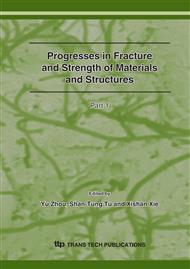p.195
p.199
p.203
p.207
p.211
p.215
p.219
p.223
p.227
Tearing Energy for Crack Growth at the Bonds of Cylindrical Rubber Bushes Subjected to Axial Shear
Abstract:
We applied the fracture mechanics approach and the nonlinear finite element method to the analysis of interfacial failure in cylinder rubber bush bonded on their outer and inner curves surfaces to rigid metal cylinders. The fracture parameter, tearing energy for rubber bushes was calculated using global energy change. The contact of interfacial crack during deformation was considered. The analyses for initially small cracks and relatively large cracks growing downwards disagree with the previous linear solutions. The variation tearing energy for cracks growing upwards is consistent with the existed results except a small range of crack length at the bottom end, where negative tearing energies exist which indicates a small crack is unexpected to initiate.
Info:
Periodical:
Pages:
211-214
Citation:
Online since:
September 2007
Authors:
Price:
Сopyright:
© 2007 Trans Tech Publications Ltd. All Rights Reserved
Share:
Citation:


